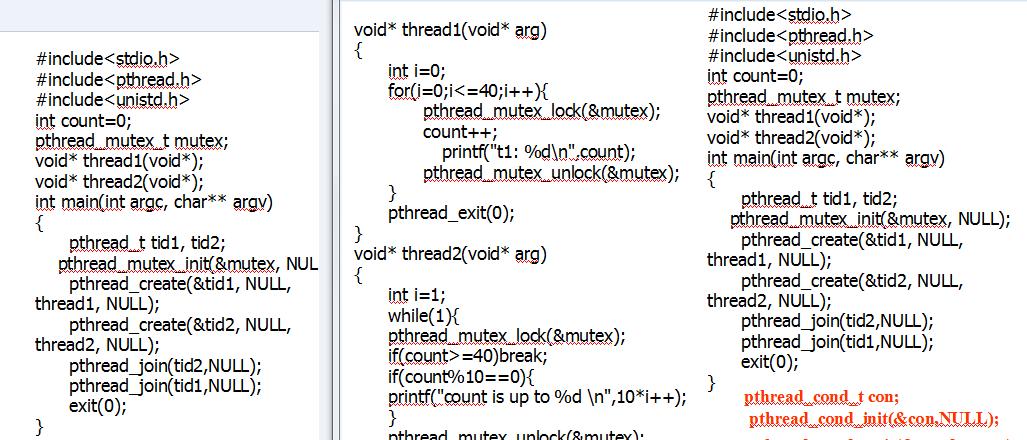- 时间:2023-05-29 10:16:55
- 浏览:
众所周知,多线程程序可以提高程序的效率,但是线程之间的同步问题也是无法避免的。在Linux系统中,有许多线程同步函数可以帮助我们解决这些问题。本文将对这些函数进行总结和分析,帮助读者更好地掌握多线程编程技能。
一、互斥锁(Mutex)
互斥锁是最常用的一种线程同步机制。当一个线程获得了互斥锁后,其他线程就无法再获得该锁,直到该线程释放了锁。在Linux系统中,我们可以使用pthread_mutex_init()函数来创建一个互斥锁,使用pthread_mutex_lock()函数来加锁,使用pthread_mutex_unlock()函数来解锁。
下面是一个简单的互斥锁使用示例:
#include<stdio.h>
#include<stdlib.h>
#include<pthread.h>
pthread_mutex_tmutex;
void*thread_func(void*arg){
pthread_mutex_lock(&mutex);
printf("Thread%dgotthelock!\n",*(int*)arg);
sleep(1);
printf("Thread%dreleasedthelock!\n",*(int*)arg);
pthread_mutex_unlock(&mutex);
returnNULL;
}
intmain(void){
pthread_tthread1,thread2;
intarg1=1,arg2=2;
pthread_mutex_init(&mutex,NULL);
pthread_create(&thread1,NULL,thread_func,&arg1);
pthread_create(&thread2,NULL,thread_func,&arg2);
pthread_join(thread1,NULL);
pthread_join(thread2,NULL);
pthread_mutex_destroy(&mutex);
return0;
}
在上面的例子中,我们创建了两个线程,它们都要访问共享资源。使用互斥锁可以确保同一时间只有一个线程可以访问该资源,从而避免了竞态条件(RaceCondition)的出现。
二、条件变量(ConditionVariable)
条件变量是另一种线程同步机制,它可以用于等待某个条件的发生。当一个线程需要等待某个条件时,它可以调用pthread_cond_wait()函数来阻塞自己,并释放互斥锁。当其他线程改变了该条件后,会调用pthread_cond_signal()或pthread_cond_broadcast()函数来唤醒等待的线程。
下面是一个简单的条件变量使用示例:
#include<stdio.h>
#include<stdlib.h>
#include<pthread.h>
pthread_mutex_tmutex;
pthread_cond_tcond;
void*thread_func(void*arg){
printf("Thread%diswaiting...\n",*(int*)arg);
pthread_mutex_lock(&mutex);
pthread_cond_wait(&cond,&mutex);
printf("Thread%disawake!\n",*(int*)arg);
pthread_mutex_unlock(&mutex);
returnNULL;
}
intmain(void){
pthread_tthread1,thread2;
intarg1=1,arg2=2;
pthread_mutex_init(&mutex,NULL);
pthread_cond_init(&cond,NULL);
pthread_create(&thread1,NULL,thread_func,&arg1);
pthread_create(&thread2,NULL,thread_func,&arg2);
sleep(1);
printf("Signalthewaitingthreads!\n");
pthread_cond_signal(&cond);
pthread_join(thread1,NULL);
pthread_join(thread2,NULL);
pthread_mutex_destroy(&mutex);
pthread_cond_destroy(&cond);
return0;
}
在上面的例子中,我们创建了两个线程,它们都需要等待某个条件的发生。使用条件变量可以让这些线程阻塞自己,并等待其他线程改变该条件后唤醒它们。
三、读写锁(Read-WriteLock)
读写锁是一种特殊的互斥锁,它允许多个线程同时读取共享资源,但只允许一个线程写入共享资源。在Linux系统中,我们可以使用pthread_rwlock_init()函数来创建一个读写锁,使用pthread_rwlock_rdlock()函数来加读锁,使用pthread_rwlock_wrlock()函数来加写锁,使用pthread_rwlock_unlock()函数来解锁。
下面是一个简单的读写锁使用示例:
#include<stdio.h>
#include<stdlib.h>
#include<pthread.h>
pthread_rwlock_trwlock;
intshared_data=0;
void*reader_func(void*arg){
inti;
for(i=0;i<3;i++){
pthread_rwlock_rdlock(&rwlock);
printf("Reader%dreadtheshareddata:%d\n",*(int*)arg,shared_data);
pthread_rwlock_unlock(&rwlock);
sleep(1);
}
returnNULL;
}
void*writer_func(void*arg){
inti;
for(i=0;i<3;i++){
pthread_rwlock_wrlock(&rwlock);
shared_data++;
printf("Writer%dwrotetheshareddata:%d\n",*(int*)arg,shared_data);
pthread_rwlock_unlock(&rwlock);
sleep(1);
}
returnNULL;
}
intmain(void){
pthread_treader1,reader2,writer1,writer2;
intarg1=1,arg2=2;
pthread_rwlock_init(&rwlock,NULL);
pthread_create(&reader1,NULL,reader_func,&arg1);
pthread_create(&reader2,NULL,reader_func,&arg2);
pthread_create(&writer1,NULL,writer_func,&arg1);
pthread_create(&writer2,NULL,writer_func,&arg2);
pthread_join(reader1,NULL);
pthread_join(reader2,NULL);
pthread_join(writer1,NULL);
pthread_join(writer2,NULL);
pthread_rwlock_destroy(&rwlock);
return0;
}
在上面的例子中,我们创建了两个读线程和两个写线程,它们都要访问共享资源。使用读写锁可以让多个线程同时读取该资源,但只允许一个线程写入该资源,从而避免了竞态条件的出现。
四、自旋锁(SpinLock)
自旋锁是另一种互斥锁,它不会使线程进入阻塞状态,而是在获取锁失败时不断尝试获取锁,直到获取到为止。在Linux系统中,我们可以使用pthread_spin_init()函数来创建一个自旋锁,使用pthread_spin_lock()函数来加锁,使用pthread_spin_unlock()函数来解锁。
下面是一个简单的自旋锁使用示例:
#include<stdio.h>
#include<stdlib.h>
#include<pthread.h>
pthread_spinlock_tspinlock;
intshared_data=0;
void*thread_func(void*arg){
inti;
for(i=0;i<3;i++){
pthread_spin_lock(&spinlock);
shared_data++;
printf("Thread%dwrotetheshareddata:%d\n",*(int*)arg,shared_data);
pthread_spin_unlock(&spinlock);
sleep(1);
}
returnNULL;
}
intmain(void){
pthread_tthread1,thread2;
intarg1=1,arg2=2;
pthread_spin_init(&spinlock,PTHREAD_PROCESS_PRIVATE);
pthread_create(&thread1,NULL,thread_func,&arg1);
pthread_create(&thread2,NULL,thread_func,&arg2);
pthread_join(thread1,NULL);
pthread_join(thread2,NULL);
pthread_spin_destroy(&spinlock);
return0;
}
在上面的例子中,我们创建了两个线程,它们都要访问共享资源。使用自旋锁可以让线程不断尝试获取锁,从而避免了进入阻塞状态的开销。
五、信号量(Semaphore)
信号量是一种计数器,它可以用于控制同时访问共享资源的线程数量。在Linux系统中,我们可以使用sem_init()函数来创建一个信号量,使用sem_wait()函数来减少计数器的值(如果计数器的值为0,则阻塞该线程),使用sem_post()函数来增加计数器的值。
下面是一个简单的信号量使用示例:
#include<stdio.h>
#include<stdlib.h>
#include<pthread.h>
#include<semaphore.h>
sem_tsem;
intshared_data=0;
void*thread_func(void*arg){
inti;
for(i=0;i<3;i++){
sem_wait(&sem);
shared_data++;
printf("Thread%dwrotetheshareddata:%d\n",*(int*)arg,shared_data);
sem_post(&sem);
sleep(1);
}
returnNULL;
}
intmain(void){
pthread_tthread1,thread2;
intarg1=1,arg2=2;
sem_init(&sem,0,1);
pthread_create(&thread1,NULL,thread_func,&arg1);
pthread_create(&thread2,NULL,thread_func,&arg2);
pthread_join(thread1,NULL);
pthread_join(thread2,NULL);
sem_destroy(&sem);
return0;
}
在上面的例子中,我们创建了两个线程,它们都要访问共享资源。使用信号量可以控制同时访问该资源的线程数量,从而避免了过多的竞争。
结论
本文对Linux中常用的线程同步函数进行了总结和分析。互斥锁、条件变量、读写锁、自旋锁和信号量都是非常重要的线程同步机制,它们可以帮助我们解决多线程编程中的各种问题。在实际编程中,我们应该根据实际情况选择适当的同步机制,以确保程序的正确性和稳定性。

whatsapp官网版下载:https://cjge-manuscriptcentral.com/software/1921.html




